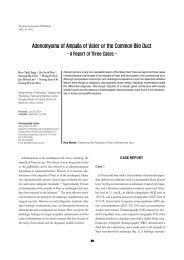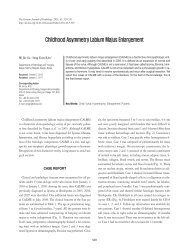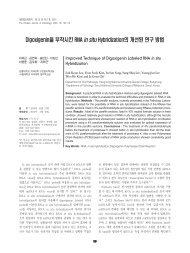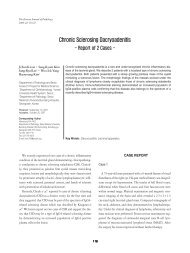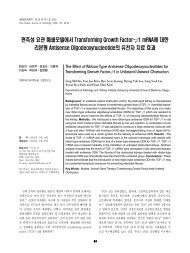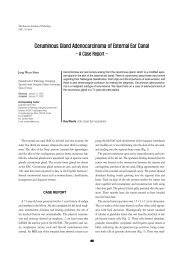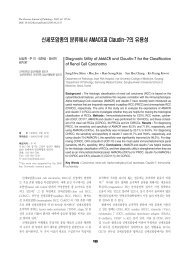Partial Trisomy 13 (Patau Syndrome) - The Korean Journal of ...
Partial Trisomy 13 (Patau Syndrome) - The Korean Journal of ...
Partial Trisomy 13 (Patau Syndrome) - The Korean Journal of ...
You also want an ePaper? Increase the reach of your titles
YUMPU automatically turns print PDFs into web optimized ePapers that Google loves.
대한병리학회지: 제 36 권제5 호 2002<br />
<strong>The</strong> <strong>Korean</strong> <strong>Journal</strong> <strong>of</strong> Pathology. 2002; 36: 338-40<br />
<strong>Partial</strong> <strong>Trisomy</strong> <strong>13</strong> (<strong>Patau</strong> <strong>Syndrome</strong>)<br />
- An Autopsy Report -<br />
Kyung Chan Choi∙Hyung Sik Shin<br />
Young Euy Park∙Jung Lae Seo 1<br />
Sung Won Lee 1 ∙Eu Sun Ro 1<br />
Departments <strong>of</strong> Pathology and 1 Obstetrics<br />
and Gynecology, College <strong>of</strong> Medicine<br />
Hallym University, Chuncheon;<br />
Department <strong>of</strong> 2 Obstetrics and<br />
Gynecology, Pohang Christian Hospital,<br />
Pohang, Korea<br />
<strong>Trisomy</strong> <strong>13</strong> (<strong>Patau</strong> syndrome) is rare and usually fatal if contracted within the first six months<br />
<strong>of</strong> life. We report a case <strong>of</strong> a male fetus with the typical features <strong>of</strong> <strong>Patau</strong> syndrome. He was<br />
terminated in a 27-year-old mother at the gestational age <strong>of</strong> 32 +4 weeks. In chromsomal analysis<br />
by GTG banding technique, the karyotype <strong>of</strong> the fetus was 46,XY,rec(<strong>13</strong>)<br />
dup(<strong>13</strong>q)inv(<strong>13</strong>)(p<strong>13</strong>q21.3)(=partial trisomy <strong>13</strong>q); and his mother’s karyotype was 46,XX,<br />
inv(<strong>13</strong>)(p<strong>13</strong>q21.3)(=pericentric inversion). His father had normal karyotype, 46,XY. Ultrasonography<br />
showed fluid-nature content, which was occupying the entire intracranium, but<br />
preserving the brain stem and cerebellum. Postmortem examination disclosed holoprosencephaly,<br />
hydrocephalus, a single nostril, bilateral anophthalmia, ventricular septal defect, and<br />
a single umbilical artery.<br />
Yong Pil Kim 2 338<br />
Received : January 30, 2002<br />
Accepted : August 3, 2002<br />
Corresponding Author<br />
Kyung Chan Choi, M.D.<br />
Department <strong>of</strong> Pathology, Chuncheon Sacred Heart<br />
Hospital, Hallym University, 153 Kyo-dong,<br />
Chuncheon 200-073, Korea<br />
Tel: 033-252-9970<br />
Fax: 033-256-4161<br />
E-mail: kcchoi@hallym.ac.k<br />
Key Words : Autopsy-<strong>Trisomy</strong>-Holoprosencephaly-Karyotyping<br />
<strong>Trisomy</strong> <strong>13</strong> was first described in 1960 by <strong>Patau</strong>, who linked<br />
chromosomal defect with a variety <strong>of</strong> congenital malformations. 1<br />
<strong>The</strong>se include those <strong>of</strong> the central nervous system (mental deficiency,<br />
motor seizures, deafness, moderate microcephaly and<br />
microphthalmia), cleft lips with or without cleft palate, cardiac<br />
malformations in 80% <strong>of</strong> cases (ventricular septal defect, patent<br />
ductus arteriosus, cardiomyopathy and dextroposition), and polydactyly<br />
hands and, sometimes, feet. It is one <strong>of</strong> the three main<br />
autosomal trisomies compatible with life, the others being trisomies<br />
21 and 18. 2 We report a rare case <strong>of</strong> partial trisomy <strong>13</strong>.<br />
CASE REPORT<br />
A male fetus was terminated in a 27-year-old female at the<br />
gestational period <strong>of</strong> 32 +4 weeks. Antenatal ultrasonic examination<br />
revealed a cystic brain with a relatively preserved brain<br />
stem and cerebellum. Tests for hepatitis B surface antigen and<br />
syphilis were negative, and the mother’s blood group was AB,<br />
Rh-positive. <strong>The</strong> placenta weighed 600 g. <strong>The</strong> fetus’s heart rate<br />
was 80/minute, and its heartbeat was very weak. <strong>The</strong> Apgar<br />
scores were 2 at 1 minute and 0 at 5 minutes. An external<br />
examination showed a hydropic neonate, weighing 2,000 g and<br />
having a crown-heel length <strong>of</strong> 46 cm. <strong>The</strong> head, measuring 29<br />
cm in circumference, appeared large in comparison to the rest <strong>of</strong><br />
the body. Both eyebrows were attached. Cyanosis was found in<br />
the lip, face and nail beds. <strong>The</strong> fetal skin was pale. <strong>The</strong>re was a<br />
single nostril and bilateral anophthalmia (Fig. 1A). <strong>The</strong> abdomen<br />
was distended, measuring 23 cm in circumference. Postmortem<br />
radiograph was unremarkable.<br />
On a gross examination <strong>of</strong> the internal organs, the heart<br />
revealed a ventricular septal defect and patent ductus arteriosus.<br />
<strong>The</strong> distended abdominal cavity was filled with amber fluid.<br />
<strong>The</strong> brain weighed 109g and measured 11×7×2 cm. Holo-<br />
338
<strong>Partial</strong> <strong>Trisomy</strong> <strong>13</strong> (<strong>Patau</strong> <strong>Syndrome</strong>) 339<br />
prosencephaly, (type 1, cyclopia) indicating the failure <strong>of</strong> separation<br />
<strong>of</strong> prosencephalon, and hydrocephalus were found (Fig.<br />
1B). Other internal organs including the lungs, thymus, spleen,<br />
gastrointestinal tract, liver, pancreas, kidneys, adrenal glands<br />
and urinary bladder were unremarkable. Histologically, cerebellar<br />
folia displayed a polymicrogyria pattern with further division.<br />
Choroid plexus epithelium was found. <strong>The</strong> umbilical cord<br />
showed a single umbilical artery. <strong>The</strong> liver, lung, spleen, and<br />
kidney were congested.<br />
Chromosomal analysis <strong>of</strong> peripheral blood lymphocytes after<br />
birth showed 46,XY,rec(<strong>13</strong>)dup(<strong>13</strong>q)inv(<strong>13</strong>)(p<strong>13</strong>q21.3)(=partial<br />
trisomy <strong>13</strong>q) in the neonate (Fig. 2A) and 46,XX,inv(<strong>13</strong>)<br />
(p<strong>13</strong>q21.3)(=pericentric inversion) in its mother (Fig. 2B),<br />
while its father had normal karyotype.<br />
DISCUSSION<br />
<strong>The</strong> classical features <strong>of</strong> <strong>Patau</strong> syndrome, or trisomy <strong>13</strong>, are<br />
defects <strong>of</strong> the auricles, eyes (microphthalmia, iris coloboma,<br />
strabismus, etc), and mouth (cleft lip, palate or both), holoprosencephaly<br />
sequence (including arrhinencephaly, cebocephaly,<br />
and others), hemangiomas, polydactyly, hyperconvex fingernails,<br />
scalp defects, and heart defects. <strong>The</strong>y are usually severe<br />
enough to ensure death within months <strong>of</strong> birth. 3<br />
<strong>The</strong> incidence <strong>of</strong> trisomy <strong>13</strong> is about 1 in 15,000 births. It is<br />
10 20 30<br />
A<br />
10 20 30<br />
B<br />
Fig. 1. (A) Gross examination shows enlarged head, short neck, one nostril and anophthalmia. (B) Holoprosencephaly and hydrocephalus<br />
are seen in the coronal sections <strong>of</strong> brain.<br />
q34<br />
p<strong>13</strong><br />
q21.3<br />
p<strong>13</strong><br />
q21.3<br />
q21.3<br />
q<strong>13</strong><br />
q21.3<br />
p<strong>13</strong><br />
q34<br />
q34<br />
A<br />
B<br />
Fig. 2. Kayrotype results are 46, XY, rec (<strong>13</strong>) dup (<strong>13</strong>q) inv (<strong>13</strong>)(p<strong>13</strong>q21.3)(=partial trisomy <strong>13</strong>q) in the male neonate (A) and 46, XX, inv<br />
(<strong>13</strong>)(p<strong>13</strong>q21.3)(=pericentric inversion) in his mothe (B).
340<br />
Kyung Chan Choi∙Hyung Sik Shin∙Young Euy Park, et al.<br />
Table 1. Clinical manifestations in patient with full and partial trisomy<br />
<strong>13</strong><br />
( ): not obligatory.<br />
Full trisomy <strong>13</strong> <strong>Partial</strong> trisomy <strong>13</strong><br />
Microcephaly + +<br />
Low-set ears + (+)<br />
Cleft palate + -<br />
Cleft lip + -<br />
Congenital heart disease + (+)<br />
Cryptorchidism (+) -<br />
Polydactyly + (+)<br />
Fetal hemoglobin elevation (+) (+)<br />
estimated that the frequency <strong>of</strong> trisomy <strong>13</strong> is 100 times higher<br />
in spontaneous abortions than in liveborns. 4 Magenis et al. 3<br />
reported that 28% <strong>of</strong> the few surviving liveborns died in the<br />
first week after birth, 44% within the first month and 86%<br />
within their first year. <strong>The</strong> median survival <strong>of</strong> children with trisomy<br />
<strong>13</strong> was given as 89.2 days. Only one adult, aged 33, is<br />
known to be still alive; the longevity is presumed to be due to<br />
absence <strong>of</strong> severe cerebral and cardiovascular abnormalities.<br />
It is assumed that the triplication <strong>of</strong> a chromosome that carries<br />
a high number <strong>of</strong> genes causes serious interference within a<br />
multigene-system and that the phenotype <strong>of</strong> a particular trisomy<br />
is more likely created by a pattern <strong>of</strong> the indirect effects <strong>of</strong><br />
the gene imbalance than by the direct effect <strong>of</strong> gene actions.<br />
<strong>Partial</strong> duplications for proximal segments (<strong>13</strong> q11→q14) alone<br />
show some features <strong>of</strong> <strong>Patau</strong> syndrome: including strabismus,<br />
depressed nasal bridge, stubby nose, cleft lip/palate, clinodactyly,<br />
increased polymorphonuclear (PMN) projections <strong>of</strong> the segmented<br />
neutrophils, and persistence <strong>of</strong> Hb F. Patients with distal<br />
<strong>13</strong>q duplications (<strong>13</strong>q14→qter) typically show other features<br />
overlapping those <strong>of</strong> full trisomy <strong>13</strong>. In this case, distal<br />
<strong>13</strong>q duplication (inv, q21.3) may induce a defect <strong>of</strong> dividing<br />
into both hemisphere. Some studies suggest that both proximal<br />
and distal duplications are needed for full manifestations <strong>of</strong><br />
<strong>Patau</strong> syndrome. Thus, a clear phenotype-karyotype correlation<br />
has not been established. Possible explanations for this study <strong>of</strong><br />
the defect include: (1) partial duplications <strong>of</strong> <strong>13</strong> are usually associated<br />
with aneuploidis for other chromosomal segments, (2)<br />
gene interactions, (3) imprinting effects, (4) interchromosomal<br />
effects (Table 1). 5<br />
Naor et al. 6 stated that besides genetic factors causing malformations<br />
in children with trisomy <strong>13</strong>, unknown exogenous<br />
agents must be taken into account as possible mechanisms.<br />
Boyd et al. 7 reported the increased occurrence <strong>of</strong> pre-eclampsia<br />
in mothers <strong>of</strong> children with trisomy <strong>13</strong> (5/14) in comparison<br />
with mothers <strong>of</strong> children with trisomy 21 and 18 and mothers<br />
<strong>of</strong> children without chromosomal anomalies (0/28). It still<br />
remains to be proven whether a chromosomal anomaly in the<br />
child has any influence on the development <strong>of</strong> pre-eclampsia.<br />
No clinical evidence <strong>of</strong> pre-eclampsia was present in our case.<br />
REFERENCES<br />
1. <strong>Patau</strong> K, Smith DW, <strong>The</strong>rman E, Inhorn SI, Wagner HP. Multiple<br />
congenital anomaly caused by an extra chromosome. Lancet 1960; 1:<br />
760.<br />
2. Boue J, Boue A, Lazou P. Retrospective and prospective epidemiological<br />
studies <strong>of</strong> 1500 karyotyped spontaneous human abortions.<br />
Teratology 1975; 12: 11-26.<br />
3. Magenis ER, Hecht F, Milham S. <strong>Trisomy</strong>-<strong>13</strong>(D) syndrome: studies<br />
on parental age, sex ratio, and survival. J Pediatr 1968; 73: 222-8.<br />
4. Hook EB. Rates <strong>of</strong> 47, +<strong>13</strong> and 46 translocations D/<strong>13</strong> <strong>Patau</strong> syndrome<br />
in live births and comparison with rates in fetal deaths and at<br />
amniocentesis. Am J Hum Genet 1980; 32: 849-58.<br />
5. Gropp A, Putz B, Zimmermann U. In: Group A. Benirschke K.<br />
Development biology and pathology. Berlin, Heidelberg, New<br />
York: Springer Verlag, 1986; 177-91.<br />
6. Naor N, Amir Y, Cohen T, Davidson S. <strong>Trisomy</strong> <strong>13</strong> in monozygotic<br />
twins discordant for major congenital anomalies. J Med Genet 1987;<br />
24: 500-4.<br />
7. Boyd PA. Lindenbaum RH, Redman C. Pre-eclampsia and trisomy<br />
<strong>13</strong>: a possible association. Lancet 1987; 2: 425-7.



